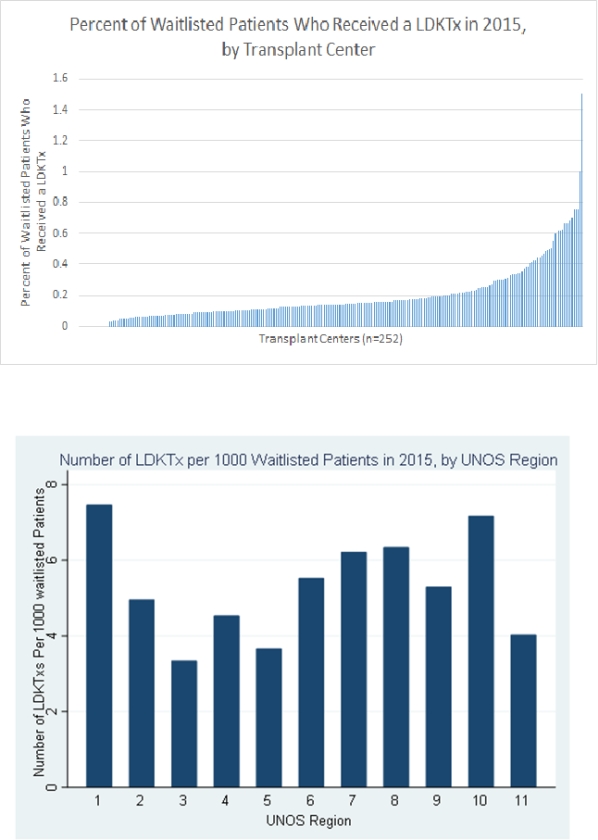Variation in Living Donor Kidney Transplantation among U.S. Transplant Centers
1Emory University, Atlanta
2Columbia University, New York.
Meeting: 2018 American Transplant Congress
Abstract number: C121
Keywords: Kidney transplantation
Session Information
Session Name: Poster Session C: Kidney Living Donor Issues
Session Type: Poster Session
Date: Monday, June 4, 2018
Session Time: 6:00pm-7:00pm
 Presentation Time: 6:00pm-7:00pm
Presentation Time: 6:00pm-7:00pm
Location: Hall 4EF
Introduction: Living donor kidney transplant (LDKTx) is the preferred treatment for patients with end-stage renal disease (ESRD) but continues to be less common than deceased donor KTx (DDKTx). We examine what transplant center-level factors may be driving variation in LDKTx rates.
Methods: We used data from the United Network for Organ Sharing (UNOS) and the United States Renal Data System (USRDS) to describe variation in LDKTx and examine factors associated with rates of LDKTx among prevalent waitlisted patients in 2015. We graphed the distribution of LDKTx rates at the transplant center level and mean LDKTxs per month across UNOS regions. We used ANOVA to test the statistical significance of differences across UNOS regions. We examined what transplant center factors drive differences in LDKTx using bivariable Ordinary Least Squares (region, DDKTx rates, percent black patients, profit status, average age).
Results: The distribution of LDKTxs  suggests that while most centers perform few LDKTxs, some perform far more (Range: 0-15/1000 waitlisted patients). The median rate of LDKTxs at a transplant center in 2015 was 1.4/1000 waitlisted patients but the mean rate was almost 36% higher (1.9/1000 waitlisted patients). UNOS region averages
suggests that while most centers perform few LDKTxs, some perform far more (Range: 0-15/1000 waitlisted patients). The median rate of LDKTxs at a transplant center in 2015 was 1.4/1000 waitlisted patients but the mean rate was almost 36% higher (1.9/1000 waitlisted patients). UNOS region averages  show that centers in region 1 average twice the rate of LDKTXs than in region 3 (7.5 vs 3.3, per 1000 waitlisted patients). ANOVA results show most regions are significantly different from region 1 (p<0.001), with the exception of 10. Centers that perform more DDKTxs had more LDKTtxs: one additional DDKTx/year was associated with an additional 0.41 LDKTx (p<0.001). Hospital affiliation, profit status, and average age at waitlisting were not associated with the number of LDKTxs. The percentage of waitlisted patients that were black was not associated with the number of LDKTxs but was marginally associated with the number of total KTxs (p=0.06).
show that centers in region 1 average twice the rate of LDKTXs than in region 3 (7.5 vs 3.3, per 1000 waitlisted patients). ANOVA results show most regions are significantly different from region 1 (p<0.001), with the exception of 10. Centers that perform more DDKTxs had more LDKTtxs: one additional DDKTx/year was associated with an additional 0.41 LDKTx (p<0.001). Hospital affiliation, profit status, and average age at waitlisting were not associated with the number of LDKTxs. The percentage of waitlisted patients that were black was not associated with the number of LDKTxs but was marginally associated with the number of total KTxs (p=0.06).
Conclusions: The number of LDKTxs performed at a transplant center varies considerably. Regional variation in LDKT suggests that initiatives to encourage living donation may be beneficial, especially in regions that are lagging behind in LDKTxs.
CITATION INFORMATION: Melanson T., Basu M., Plantiga L., Pastan S., Mohan S., Patzer R. Variation in Living Donor Kidney Transplantation among U.S. Transplant Centers Am J Transplant. 2017;17 (suppl 3).
To cite this abstract in AMA style:
Melanson T, Basu M, Plantiga L, Pastan S, Mohan S, Patzer R. Variation in Living Donor Kidney Transplantation among U.S. Transplant Centers [abstract]. https://atcmeetingabstracts.com/abstract/variation-in-living-donor-kidney-transplantation-among-u-s-transplant-centers/. Accessed December 20, 2025.« Back to 2018 American Transplant Congress
